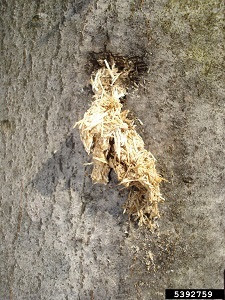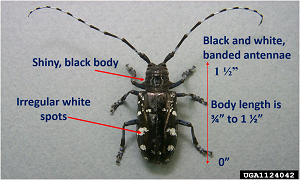August is Tree Check Month


Check trees for signs of the invasive Asian longhorned beetle
The U.S Department of Agriculture has declared August as national Tree Check Month – time to be on the lookout for invasive, destructive pests threatening Michigan’s urban and forest landscapes.
The Michigan departments of Agriculture and Rural Development, Environmental Quality and Natural Resources are asking people to take just 10 minutes this month to check trees around homes for Asian longhorned beetle or any signs of the damage it causes.
What do they look like?
Adult Asian longhorned beetles are distinctively large, ranging from three-quarters of an inch to 1 1/2 inches in length, not including their long antennae. The beetles are shiny black, with random white blotches or spots, and their antennae have alternating black and white segments. They have six legs that can be black or partly blue, with blue coloration sometimes extending to their feet.
Where are they found?
The Asian longhorned beetle was first identified in the United States in 1996, likely transported from Asia in wood packing materials. To date, there are no known infestations of Asian longhorned beetle in Michigan. However, the beetle has been found in areas of Ohio, Massachusetts, New York, New Jersey, Illinois and Toronto, Ontario.
“Though the beetle does not move long distances on its own, it can be transported in firewood,” said John Bedford, Pest Response Program specialist at the Michigan Department of Agriculture and Rural Development. “When traveling, leave your firewood at home. Buy it at your destination point and burn it there.”
Why be concerned?
Like the emerald ash borer, the Asian longhorned beetle spends most of its life cycle eating its way through the insides of trees. What makes this beetle much more dangerous is that it feeds on a wide variety of tree species. Its first choice is maple, but it also will infest birch, elm, willow, buckeye, horse chestnut and other hardwoods. Trees infested with Asian longhorned beetle must be destroyed to prevent the insect from spreading.
What should you look for?
Adult beetles are active in late summer to early fall. Female beetles chew depressions in tree trunks and branches to lay eggs. When larvae hatch, they burrow deep into the heartwood of the tree, creating large chambers in the wood. The next summer, fully formed adult beetles emerge from trees by boring perfectly round, three-eighths-inch-diameter exit holes. Sometimes a material resembling wood shavings can be seen at or below these holes or coming from cracks in an infested tree’s bark.
Look-alikes
Several native beetles and bugs often are mistaken for the Asian longhorned beetle.
- The white spotted pine sawyer has a distinctive white spot below the base of its head – between its wings – and is brownish in color.
- The cottonwood borer is about the same size as the Asian longhorned beetle and also black and white – but the cottonwood borer has a pattern of single, broad black stripes down each wing, and its antennae are all dark.
- The northeastern pine sawyer reaches up to 2 inches in length, has very long antennae and is gray in color.
- The eastern eyed click beetle has distinctive eye-circles on the back of its head. It rolls over when threatened, then clicks and makes a flipping movement to get back on its feet.
Anyone observing an Asian longhorned beetle, or a tree that appears to have been damaged by it, is asked to report it. If possible, capture the beetle in a jar, take photos, record the location, and report it as soon as possible to the USDA at www.asianlonghornedbeetle.com or contact MDARD at 800-292-3939 or MDA-info@michigan.gov.
More information can be found on the Michigan Invasive Species website’s Asian longhorned beetle page.
Contact: John Bedford (MDARD), 517-284-5650, bedfordj@michigan.gov or Joanne Foreman (DNR), 517-284-5814, foremanj@michigan.gov






